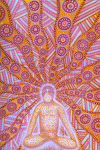The tilak or pottu invokes a feeling of sanctity in the wearer and others. It is recognized as a religious mark. Its form and colour vary according to one’s caste, religious sect or the form of the Lord worshipped.
In earlier times, the four castes (based on varna or colour) - Brahmana, Kshatriya, Vaishya and Sudra - applied marks differently. The brahmin applied a white chandan mark signifying purity, as his profession was of a priestly or academic nature. The kshatriya applied a red kumkum mark signifying valour as he belonged to warrior races. The vaishya wore a yellow kesar or turmeric mark signifying prosperity as he was a businessman or trader devoted to creation of wealth. The sudra applied a black bhasma, kasturi or charcoal mark signifying service as he supported the work of the other three divisions.
Also Vishnu worshippers apply a chandan tilak of the shape of "U,” Shiva worshippers a tripundra of bhasma, Devi worshippers a red dot of kumkum and so on).
The tilak cover the spot between the eyebrows, which is the seat of memory and thinking. It is known as the Aajna Chakra in the language of Yoga. The tilak is applied with the prayer - "May I remember the Lord. May this pious feeling pervade all my activities. May I be righteous in my deeds.” Even when we temporarily forget this prayerful attitude the mark on another reminds us of our resolve. The tilak is thus a blessing of the Lord and a protection against wrong tendencies and forces.
The entire body emanates energy in the form of electromagnetic waves - the forehead and the subtle spot between the eyebrows especially so. That is why worry generates heat and causes a headache. The tilak and pottu cools the forehead, protects us and prevents energy loss. Sometimes the entire forehead is covered with chandan or bhasma. Using plastic reusable "stick bindis" is not very beneficial, even though it serves the purpose of decoration.
Friday, December 28, 2007
Sunday, December 16, 2007
Why do we prostrate before parents and elders?
Indians prostrate before their parents, elders, teachers and noble souls by touching their feet. The elder in turn blesses us by placing his or her hand on or over our heads. Prostration is done daily, when we meet elders and particularly on important occasions like the beginning of a new task, birthdays, festivals etc. In certain traditional circles, prostration is accompanied by abhivaadana, which serves to introduce one-self, announce one’s family and social stature.
Man stands on his feet. Touching the feet in prostration is a sign of respect for the age, maturity, nobility and divinity that our elders personify. It symbolizes our recognition of their selfless love for us and the sacrifices they have done for our welfare. It is a way of humbly acknowledging the greatness of another. This tradition reflects the strong family ties, which has been one of India’s enduring strengths.
The good wishes (Sankalpa) and blessings (aashirvaada) of elders are highly valued in India. We prostrate to seek them. Good thoughts create positive vibrations. Good wishes springing from a heart full of love, divinity and nobility have a tremendous strength. When we prostrate with humility and respect, we invoke the good wishes and blessings of elders, which flow in the form of positive energy to envelop us. This is why the posture assumed whether it is in the standing or prone position, enables the entire body to receive the energy thus received.
The different forms of showing respect are :
Pratuthana: Rising to welcome a person.
Namaskaara: Paying homage in the form of namaste
Upasangrahan: Touching the feet of elders or teachers.
Shaashtaanga: Prostrating fully with the feet, knees, stomach, chest, forehead and arms touching the ground in front of the elder.
Pratyabivaadana: Returning a greeting.
Rules are prescribed in our scriptures as to who should prostrate to whom. Wealth, family name, age, moral strength and spiritual knowledge in ascending order of importance qualified men to receive respect. This is why a king though the ruler of the land, would prostrate before a spiritual master. Epics like the Ramayana and Mahabharata have many stories highlighting this aspect.
Man stands on his feet. Touching the feet in prostration is a sign of respect for the age, maturity, nobility and divinity that our elders personify. It symbolizes our recognition of their selfless love for us and the sacrifices they have done for our welfare. It is a way of humbly acknowledging the greatness of another. This tradition reflects the strong family ties, which has been one of India’s enduring strengths.
The good wishes (Sankalpa) and blessings (aashirvaada) of elders are highly valued in India. We prostrate to seek them. Good thoughts create positive vibrations. Good wishes springing from a heart full of love, divinity and nobility have a tremendous strength. When we prostrate with humility and respect, we invoke the good wishes and blessings of elders, which flow in the form of positive energy to envelop us. This is why the posture assumed whether it is in the standing or prone position, enables the entire body to receive the energy thus received.
The different forms of showing respect are :
Pratuthana: Rising to welcome a person.
Namaskaara: Paying homage in the form of namaste
Upasangrahan: Touching the feet of elders or teachers.
Shaashtaanga: Prostrating fully with the feet, knees, stomach, chest, forehead and arms touching the ground in front of the elder.
Pratyabivaadana: Returning a greeting.
Rules are prescribed in our scriptures as to who should prostrate to whom. Wealth, family name, age, moral strength and spiritual knowledge in ascending order of importance qualified men to receive respect. This is why a king though the ruler of the land, would prostrate before a spiritual master. Epics like the Ramayana and Mahabharata have many stories highlighting this aspect.
Sunday, December 9, 2007
Why do we do 'Namaste'?
Indians greet each other with namaste. The two palms are placed together in front of the chest and the head bows whilst saying the word namaste. This greeting is for all - people younger than us, of our own age, those older than friends, even strangers and us.
There are five forms of formal traditional greeting enjoined in the shaastras of which namaskaram is one. This is understood as prostration but it actually refers to paying homage as we do today when we greet each other with a namaste.
Namaste could be just a casual or formal greeting, a cultural convention or an act of worship. However there is much more to it than meets the eye. In Sanskrit namah + te = namaste. It means - I bow to you - my greetings, salutations or prostration to you. Namaha can also be literally interpreted as "na ma" (not mine). It has a spiritual significance of negating or reducing one’s ego in the presence of another.
The real meeting between people is the meeting of their minds. When we greet another, we do so with namaste, which means, "may our minds meet," indicated by the folded palms placed before the chest. The bowing down of the head is a gracious form of extending friendship in love and humility.
The spiritual meaning is even deeper. The life force, the divinity, the Self or the Lord in me is the same in all. Recognizing this oneness with the meeting of the palms, we salute with head bowed the Divinity in the person we meet. That is why sometimes, we close our eyes as we do namaste to a revered person or the Lord – as if to look within. The gesture is often accompanied by words like "Ram Ram,” "Jai Shri Krishna", "Namo Narayana", "Jai Siya Ram", "Om Shanti" etc - indicating the recognition of this divinity.
When we know this significance, our greeting does not remain just a superficial gesture or word but paves the way for a deeper communion with another in an atmosphere of love and respect.
There are five forms of formal traditional greeting enjoined in the shaastras of which namaskaram is one. This is understood as prostration but it actually refers to paying homage as we do today when we greet each other with a namaste.
Namaste could be just a casual or formal greeting, a cultural convention or an act of worship. However there is much more to it than meets the eye. In Sanskrit namah + te = namaste. It means - I bow to you - my greetings, salutations or prostration to you. Namaha can also be literally interpreted as "na ma" (not mine). It has a spiritual significance of negating or reducing one’s ego in the presence of another.
The real meeting between people is the meeting of their minds. When we greet another, we do so with namaste, which means, "may our minds meet," indicated by the folded palms placed before the chest. The bowing down of the head is a gracious form of extending friendship in love and humility.
The spiritual meaning is even deeper. The life force, the divinity, the Self or the Lord in me is the same in all. Recognizing this oneness with the meeting of the palms, we salute with head bowed the Divinity in the person we meet. That is why sometimes, we close our eyes as we do namaste to a revered person or the Lord – as if to look within. The gesture is often accompanied by words like "Ram Ram,” "Jai Shri Krishna", "Namo Narayana", "Jai Siya Ram", "Om Shanti" etc - indicating the recognition of this divinity.
When we know this significance, our greeting does not remain just a superficial gesture or word but paves the way for a deeper communion with another in an atmosphere of love and respect.
Sunday, December 2, 2007
Why do we have a prayer room?
Most Indian homes have a prayer room or altar. A lamp is lit and the Lord worshipped each day. Other spiritual practices like japa - repetition of the Lord’s name, meditation, paaraayana - reading of the scriptures, prayers, and devotional singing etc are also done here. Special worship is done on auspicious occasions like birthdays, anniversaries, festivals and the like. Each member of the family - young or old - communes with and worships the Divine here.
The Lord is the entire creation. He is therefore the true owner of the house we live in too. The prayer room is the Master room of the house. We are the earthly occupants of His property. This notion rids us of false pride and possessiveness.
The ideal attitude to take is to regard the Lord as the true owner of our homes and us as caretakers of His home. But if that is rather difficult, we could at least think of Him as a very welcome guest. Just as we would house an important guest in the best comfort, so too we felicitate the Lord’s presence in our homes by having a prayer room or altar, which is, at all times, kept clean and well-decorated.
The Lord is the entire creation. He is therefore the true owner of the house we live in too. The prayer room is the Master room of the house. We are the earthly occupants of His property. This notion rids us of false pride and possessiveness.
The ideal attitude to take is to regard the Lord as the true owner of our homes and us as caretakers of His home. But if that is rather difficult, we could at least think of Him as a very welcome guest. Just as we would house an important guest in the best comfort, so too we felicitate the Lord’s presence in our homes by having a prayer room or altar, which is, at all times, kept clean and well-decorated.
Subscribe to:
Posts (Atom)





